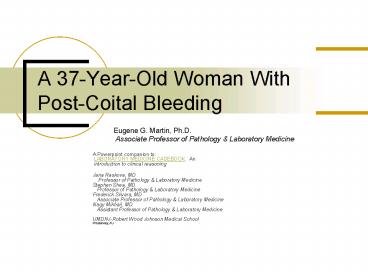A 37YearOld Woman With PostCoital Bleeding
1 / 9
Title:
A 37YearOld Woman With PostCoital Bleeding
Description:
PAP smear: One Year Earlier. PAP smear: Current. High Nuclear/cytoplasmic ratio ... indicating the site of hybirdization between target and probe DNA ... –
Number of Views:56
Avg rating:3.0/5.0
Title: A 37YearOld Woman With PostCoital Bleeding
1
A 37-Year-Old Woman With Post-Coital Bleeding
Eugene G. Martin, Ph.D. Associate Professor of
Pathology Laboratory Medicine
- A Powerpoint companion to LABORATORY MEDICINE
CASEBOOK. An introduction to clinical
reasoning - Jana Raskova, MD Professor of Pathology
Laboratory MedicineStephen Shea, MD
Professor of Pathology Laboratory
MedicineFrederick Skvara, MD Associate
Professor of Pathology Laboratory MedicineNagy
Mikhail, MD Assistant Professor of Pathology
Laboratory MedicineUMDNJ-Robert Wood Johnson
Medical SchoolPiscataway, NJ
2
History and Presentation
- 37 year old woman seen in physicians office
complaining of a two week history of post-coital
vaginal bleeding. - Previous history Two normal pregnancies. Family
history unremarkable - Physical Exam
- Slightly overweight female in no acute distress
- BP 120/85
- HR 85 bpm - regular
- Temperature 98 oF
- Chest and abdominal examination uremarkable.
- Colposcopy
- Cervix White patches following the application
of acetic acid, a well as distinct vascular
punctuation pattern. - PAP smear obtained. Previous PAP reviewed.
3
PAP SMEAR
PAP smear One Year Earlier
Normal PAP smear
- Normal mature squamous cells
- Small, pyknotic nuclei
- No perinuclear halo
- Yellow color is due to cytoplasmic glycogen
- Kilocytic atypia
- Mature squamous cells,demonstrating a large
perinuclear, lightly stained area. - Surrounding peripheral cytoplasm normal
- Slightly enlarged nuclei
- Stains much more intensely.
- Chromatin appears relatively
- No secretory or malignant cells present
4
PAP SMEAR
PAP smear One Year Earlier
PAP smear Current
- High Nuclear/cytoplasmic ratio
- Variation in nuclear size anisokaryosis
- Irregular nuclear membranes
- Hyprchromatic nuclei
- Course chromatin pattern
- DX Severe dysplasia or CIN IIIHigh-Grade
squamous intraepithelial lesion - HGSIL
- Mature squamous cells,demonstrating a large
perinuclear, lightly stained area. - Surrounding peripheral cytoplasm stains much more
intensely. - Chromatin appears relatively normal
5
Cervical Biopsy HPV In-Situ Hybirdization for
types 16 and 18
- Note Purple precipitate indicating the site of
hybirdization between target and probe DNA
6
Human Papilloma Virus
- HPV types 6,11,42 and 44 associated with
development of low risk benign condylomas - Majority of low-grade cervical intraepithelial
cells (CIN 1) exhibit features of HPV infection. - Only a small percentage develop cervical carcinoma
- HPV 16,18,31 and 33 - associated with
development of high risk cervical carcinoma. - Oncoprotein E6 of HPV types 16, 18 transforms
cells in culture by inactivation of human
suppressor gene p53. - 15 of cervical carcinoma IS NOT associated with
HPV
7
Cervical Biopsy
Patient HE x78
Norma HE x78l
- Squamous epithelium no evidence of maturation
- Loss of cell polarity
- Nuclei hyperchromatic
- Nuclear size variable
- PATTERN Severe dysplasia or Carcinoma in situ
- Normal maturation visible
- Hyperchromatic basal cells
- Flattened squamous surface cells
- Clear areas represents normal glycogen deposition
8
Predisposing factors for cervical carcinoma
- Non-sexual risk factors
- Cigarette smoking
- Use of oral contraceptives
- Lack of circumcision in male partners
- Family history of cervical carcinoma
- Sexual behaviors
- Early age at first intercourse
- Multiple sexual partners
- Male partner with previous multiple sexual
partners
9
Treatment Considerations
- CIN Cervical Cone Biopsy
- Genital warts
- Liquid N2
- Laser
- Electrocautery
- Imiquinoid cream
- Podophyllin
- Podofilox
- Treatment eliminates the wart, but not the virus!
- Complications
- Although most HPV infections, fail to progress to
cancer, it is important in the presence of
cervical dysplasia to have regular PAP smears - 1500 of CIN III will develop invasive carcinoma
later - Pregnancy physical obstruction, modification of
the elasticity of the vaginal wall is reduced































